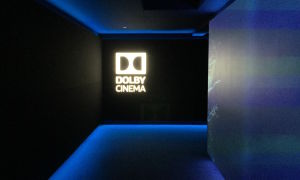
Earlier in the year, our own Sebastian Anthony had the opportunity to experience the new "IMAX with laser" cinema in Leicester Square, and it didn't disappoint. Not to be outdone, Dolby Laboratories invited Ars UK to the new JT cinema with Dolby Cinema in Hilversum, the broadcasting capital of the Netherlands.
Middle-aged Ars readers may remember Dolby from the Dolby B noise reduction system used with cassette tapes. Younger Ars readers are probably more familiar with Dolby through Dolby Digital, the codec used to encode most digital audio on DVDs as well as TV broadcasts and Blu-ray discs. (Dolby Digital started out as a way to add digital surround sound to film, where the digital information is encoded on the unused space between the perforations of the 35mm film, where it can be read optically.)

The latest Dolby audio technology in cinemas is Dolby Atmos, which supports a few more audio tracks than older systems—128 of them, in fact. However, Dolby Atmos improves upon previous surround sound technologies not by simply adding more channels. Instead, it allows sounds to be dynamically placed in a 3D space. This is used to great effect when noisy objects fly over the audience; it sounds very realistic. To allow for these effects, the JT cinema in Hilversum has no fewer than 60 speakers on the walls and the ceiling of its Dolby Cinema-equipped auditorium. Dolby Atmos is currently installed in several thousand cinemas worldwide and films such as Spectre and the new Star Wars are available with a Dolby Atmos mix (in compatible cinemas).
But Dolby Atmos surround sound is only the beginning. Actually, things begin before we even enter the auditorium: a dark corridor filled with atmospheric sounds featuring an illuminated Dolby logo at the end put us in a receptive mood as we enter. The seats are large and comfortable as usual in modern cinemas. Less common is the fact that the entire auditorium is very dark or black. This avoids distractions caused by light from the screen reflecting off of the surroundings. I'm not sure how they did it, but Dolby even managed to leave out the illuminated emergency exit signs above the doors close to the screen.

A representative from Dolby Labs explained the Dolby Atmos and Dolby Vision features that together make up Dolby Cinema. Like IMAX-with-laser, Dolby Vision uses lasers as light sources instead of the usual high-intensity discharge bulb. This allows the projection to be much brighter, and the contrast level to be much higher, than with normal DLP.
To illustrate this, one projector was used to project a white circle at the 14 foot-lamberts (fL) or 48 nits illumination level that the Society of Motion Picture and Television Engineers (SMPTE) has traditionally recommended. In the analogue days, few cinemas actually reached this level, and current digital 3D projection systems certainly don't. Then the cinema switched the projector over to Dolby Vision mode, increasing the brightness to 31 fL (106 nits) and increasing the contrast ratio to 1,000,000:1. In the image above those two circles are shown side-by-side, both photos taken with the same camera settings. In person, the effect is more dramatic.
-
Inside Out projected in Dolby Vision (photographed using the Adobe RGB 1998 colour space)Iljitsch van Beijnum
-
More Inside Out.Iljitsch van Beijnum
-
Iljitsch van Beijnum
-
Look at the rather delightful dynamic range: there are regions that are very bright and very dark on the same canvas.Iljitsch van Beijnum
-
Again, another shot showing great dynamic range.Iljitsch van Beijnum
-
Iljitsch van Beijnum
-
Some other photos of the Dolby Vision screen.Iljitsch van Beijnum
-
Iljitsch van Beijnum
Finally, we were treated to several demos of the Dolby Vision system, including clips from Tomorrowland and Inside Out. In the Tomorrowland clip, the protagonist moves through a number of scenes in a world that's mostly lit by bright sunlight, but sometimes she disappears into a dark building or tunnel for a few moments. The projection system had absolutely no problem with this, showing detail in shadows even though other parts of the frame were sunlit. However, as Sebastian noted in his review of IMAX-with-laser, it's hard to draw definitive conclusions without seeing different systems side-by-side—perhaps it's just that the director of photography in these examples is really good at his job.
Inside Out is a computer-generated animated movie, and as such is free from the mundane limitations that reality imposes. The clip we got to see was one where the animated world took on a blacklight/fluorescent look with impossibly strong saturated colours, a vision that couldn't be realised using film—or by digital technologies that are trying to match film.
reader comments
68